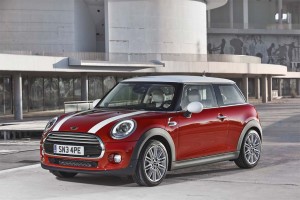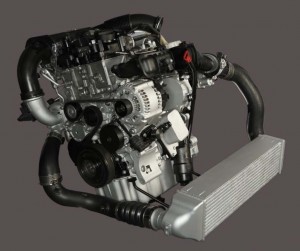Mini rolled into the L.A. Auto Show this week with an all-new version of its popular Hardtop model, but equally big news was the debut of two all-new engines.
And while the new Mini is getting a little more maxi – its overall length stretched by 4.5 inches – the third-generation Hardtop will now be offered with an engine smaller than ever, a new 1.5-liter three-cylinder package.
There’s an old adage in the auto industry that, “there’s no replacement for displacement,” but while the big V-8 may remain the icon of American muscle, the reality is that motorists have been rapidly downsizing their engine choices in recent years. Sixes have replaced eights; and now, it seems, a growing number of three-cylinder powertrains are coming to market to replace inline-fours.
That may come as a shock to those who recall the abysmal three-cylinder engines of the ‘80s and ‘90s, stone ponies that offered just one advantage: good mileage. They tended to be rough-riding and painfully slow, and reliability was an issue with more than a few of the offerings from brands such as GM’s old Geo division.
(For a first look at the new Mini Hardtop, Click Here.)
Honda brought a 3-cylinder package into the market as late as 1999, under the hood of the Insight, a quirky, teardrop-shaped hybrid. The 67-horsepower engine at least had the advantage of being paired with a small electric motor that made it possible to enter a freeway without rocket assist. But it did little to enhance the reputation of three-cylinder powertrains.
Ford gave the image a boost, however, with the recently launched 1.0-liter, three-cylinder Fiesta. While it might be the maker’s smallest powertrain, it delivers some surprising performance thanks to the use of Ford’s turbocharged EcoBoost technology. And at 123 horsepower and 148 pound-feet of torque, it’s actually the upgrade from the base 1.6-liter inline-four offered in the U.S. Fiesta line.
General Motors is getting ready to return to the three-cylinder segment – though it clearly hopes memories of the old Geo Metro model have faded away. The Detroit maker has promised to spend about $225 million on new three- and four-cylinder powertrains for the American market.
(“Anchorman” Ron Burgundy ads drive 61% surge in Dodge Durango sales. Click Here for the story.)
In fact, three cylinder engines are fairly common abroad, but manufacturers were worried, until recently, that they simply wouldn’t be accepted in America. But the latest versions are starting to allay such concerns as they manage to not only deliver impressive fuel economy numbers but eke out impressive amounts of horsepower and torque.
That the Ford three-cylinder package produces 123 hp per liter. In terms of what’s known as specific output, that’s in line with some of the world’s best sports car engines. That’s all the more impressive when you consider the basic engine block can been squeezed into a carryon bag small enough to fit into a commercial aircraft’s overhead luggage compartment.
To get there, manufacturers are using some highly advanced technologies including variable valve timing, high-pressure direct injection and turbocharging. Sophisticated computer modeling, meanwhile, has allowed engineers to design cylinders and pistons that do a better job of utilizing every BTU of energy in each squirt of fuel.
The latest multi-speed transmissions are another factor helping these new 3-cylinder engines meet customer expectations. With the latest eight- and nine-speed gearboxes, they’re more likely to always remain in the sweet spot of their torque curves which means less bogging down when it’s time to make a pass or enter a freeway.
(Hydrogen power makes a comeback at the LA Auto Show. Click Here for a look at the Hyundai Tucson Fuel Cell Vehicle debuting next spring.)
Other makers are looking to get into the 3-cylinder game. Honda recently demonstrated to TheDetroitBureau.com a new turbo inline-three that delivers a stunning level of performance for such a small package. It’s not clear, however, if that little engine will make it to the U.S. market.
But BMW will be bringing in its own 1.5-liter three-cylinder option, the engine part of the Bavarian maker’s new EfficientDynamics family. It demonstrated a prototype at its New Jersey U.S. headquarters earlier this year and could readily have fooled motorists into believing the engine was a much larger six thanks to the use of the BMW TwinPower turbo technology.
Those who follow the auto business closely might notice a connection here. And, indeed, the BMW engine is essentially the same, 3-cylinder powertrain that will be going into the new Mini Hardtop. In fact, the all-new platform for the British model will be shared with the German maker’s new 1-Series line, so it’s no wonder they’ll also be sharing engines.



I owned a Chevrolet-branded Sprint in 1986 or ’87 with a 1557 lb.curb weight, an aluminum block and head, hollow crank and cam and direct-injection that delivered 54 mpg on premium fuel. The turbo kicked in at about 50 rpm above idle and it blew the doors off everything then on the road for the first few hundred feet, while helping me develop manly forearms fighting torque steer. In city driving, it tended to sand the front tires down to the belts in about 6 weeks. But hey, in the car business you always have trade-offs and nothing’s ever really new.
I still drive one of those “quirky” Insights that I bought new in 2000. I’ve surprised many of my young friends who thought they have pretty hot cars when I’ve left them at the stoplight, and it handles almost like a sports car. It’s a blast to drive!
The reality of electric propulsion is that motors develop maximum torque as soon as they start spinning, while an IC engine must rev up. The Insight, like many battery cars, gets reasonably good launch but quickly fades back once it hits around 30 mph or so. In-town driving can be a lot of fun with even some of the more underpowered models — as long as you’re not getting onto a freeway or such. Meanwhile, it’s intriguing to see a number of makers move away from the all-out maximization of mileage to trade off for a little more performance, ie the Infiniti Q50 and the new 2014 Honda Accord (which still yields great city mileage). And Tesla, Ferrari, Porsche and McLaren are among those who truly maximize the performance potential of their hybrids, plug-ins and BEVs. Perhaps the most intriguing test will come when Acura brings out its new 3-motor system tuned for the new NSX.
Paul A. Eisenstein
Publisher, TheDetroitBureau.com
Having driven a 123 HP VW 1.4L Turbo Golf recently in Germany I can advise that these small engines are definitely managable for normal commuter use. The VW group also has a 1.2L version with even better mpg.
A low first gear is required as there is no turbo boost at idel for take-off but overall these small engines when done properly with a small turbo, are good for mpg and reasonable performance.
I expect down the road however that without premium internal components these engines are going to show premature wear as you’d expect from any engine that must run in high boost all the time to produce sufficient power for normal operation. Then emissions increase along with very expensive maintenance – because there is no free lunch in this world.
The convenience and performance of larger displacement engines should not be dismissed as engine life also tends to be extended when the engine is only subjected to modest loads vs a small engine under max load all the time.